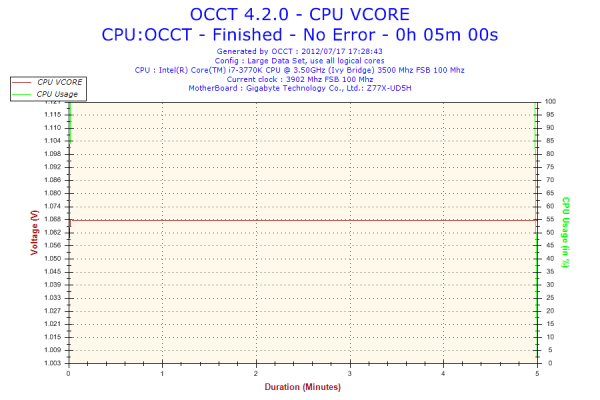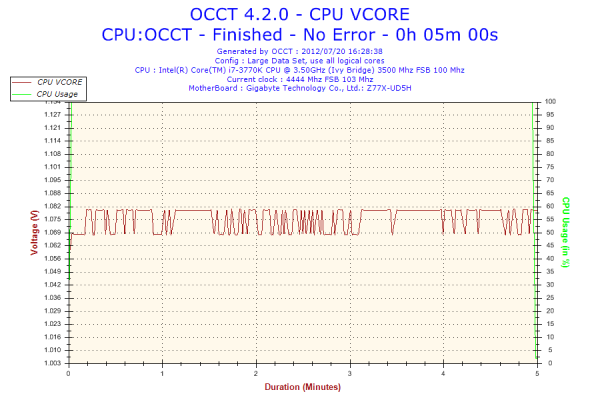Gigabyte GA-Z77X-UD5H Review: Functionality meets Competitive Pricing
by Ian Cutress on July 25, 2012 5:00 AM EST- Posted in
- Motherboards
- Gigabyte
- Z77
Gigabyte GA-Z77X-UD5H In The Box
Gigabyte boxes are typically a bit bare, to cater with Gigabyte's philosophy of trying to reach the price point below the one the board should be placed. Typically, this means not much more than a pair of SATA cables - with the Z77X-UD5H, we get:
IO Shield
Driver CD
Quick Start Guide
Manual
Four SATA cables
Flexi-SLI connector
Front USB 3.0 panel

With a motherboard that has three different USB 3.0 headers on the board, the inclusion of a USB 3.0 panel is a no-brainer. Users of modern cases will also have the opportunity to add two USB 3.0 ports of their own with the case. With the motherboard using an x8/x4/x4 combination of PCIe 3.0 lanes, it is a little surprising we do not see a rigid SLI connector here, if not for three cards then at least for two.
Voltage Readings
After my first publication of OCCT voltage readings, a few readers responded with a more in-depth reasoning behind some of the results we were seeing. With this in mind, I would like to re-describe what we are doing with this test, and how it comes about.
Much of what an enthusiast overclocker does is monitor CPU temperature and voltage. Whatever settings a user places in the BIOS or OS is at the mercy of the motherboard - in terms of actually setting the values and reporting the values back. As an enthusiast, we have to rely on what readings we get back, and hope that motherboard manufacturers are being honest with their readings.
Take CPU voltage. What we as a user see in CPU-Z or OCCT is a time-averaged value that hides voltage ripple (if any) for power delivery. It is very easy for a motherboard manufacturer to hide this value, or to disregard slight deviations and report a constant value to the user. The CPU voltage reading can be taken at a variety of places on the power plane, which can vary between motherboards and manufacturers, meaning that each reading is essentially not comparable with the other. Nevertheless, as an enthusiast, we will constantly compare value A with value B.
Whether or not I can achieve 4.7 GHz with 1.175 volts on a particular board is inconsequential - your motherboard may perhaps produce the same result with a reading at 1.200 volts. The only way to test the actual value is with consistent methodology is via an oscilloscope connected to similar points on each board. This may sound like taking an OCCT reading is therefore redundant.
However, motherboards have settings relating to load line calibration. As load is applied to the CPU, the voltage across the processor decreases (VDroop). Load Line calibration essentially attempts to control this level of droop, by increasing voltage when voltage drops are detected away from a fixed value. Manufacturers have different ideas on how to modify LLC with respect to load, or whether the level of modification should be controlled by the user. Some manufacturers offer the option at a variety of levels, such that overclockers can be sure of the applied setting (even if it increases peak voltage, as explained by AnandTech in 2007).
By doing a full load OCCT test, we are essentially determining both how aggressive the motherboard is reporting the CPU voltage under load and how aggressive load line calibration is performing (from the point of view of the user without an oscilloscope or DVM). If someone has one of the motherboards we have tested and you have a different one, variations in load voltage should describe the offset you may require for overclock comparisons.
As with previous Gigabyte boards, we get a straight line for voltage reading in OCCT. This draws distinct parallels with the previous Gigabyte Z77 boards we have tested - the Z77X-UD3H and the Z77MX-D3H. With the D3H, we found out that Gigabyte was purposely fixing this value, introducing middleware to make sure this value never changed in the OS (as it did not change during overclocking).
Therefore during overclocking on the Z77X-UD5H we also ran the test. We set the VCore in the BIOS to 1.150 volts and got the following result:
Despite the VCore being correctly reported in CPU-Z, in OCCT (in HWMonitor mode), we can see that for some reason it is being fed either the wrong data, or manipulated data. Given our previous experiences with the Gigabyte Z77MX-D3H and the fact that the data fed to OCCT was being manipulated (i.e. overclock voltages were not being fed through to the OS, but were fixed by middleware), it seems rather odd for the motherboard to be performing similarly here.
| Reported Load Voltage / V | |
| ASRock Fatal1ty Z77 Professional | 0.956 |
| ASRock Z77 Extreme4 | 1.050-1.058 |
| ASRock Z77 Extreme6 | 1.040-1.048 |
| ASUS P8Z77-V Deluxe | 1.085 |
| ASUS P8Z77-V Pro | 1.090 |
| Biostar TZ77XE4 | 1.036 |
| Gigabyte Z77X-UD5H | 1.067 |
| Gigabyte Z77X-UD3H | 1.067 |
| MSI Z77A-GD65 | 1.020 |












70 Comments
View All Comments
Dustin Sklavos - Wednesday, July 25, 2012 - link
Derp. Well, color me stupid.Nice one, though. ;)
Belard - Thursday, July 26, 2012 - link
Okay, you are stupid.Well, for another reason. Nobody makes a keyboard worthwhile to replace the one I use today... 1996 era. This keyboard *IS SO OLD*, its not even a PS/2! Its an AT-connector, plugged into a PS/2 3" Adapter into an extended PS/2 cable. A USB convert doesn't work.
But gigabyte makes many boards with ps/2 ports.
VGA is not needed on a high end board (lower end $60~120 boards have VGA).
And actually, a floppy connector *IS NOT* needed of modern boards. When a modern board like Gigabyte doesn't include a floppy connector, they can update the BIOS from within the OS or with a flash drive.... far easier than a stupid old-school floppy drive (I keep one just in case).
DigitalFreak - Wednesday, July 25, 2012 - link
Did you test the VIA USB 3 chip performance, or only the Intel PCH controller?Mustang66 - Wednesday, July 25, 2012 - link
Are the two red USB ports on the back 2.0 or 3.0? The paragraph says they're 3.0 but the feature list seems to infer they are 2.0.IanCutress - Wednesday, July 25, 2012 - link
Sorry, the red ones are USB 2.0. USB 3.0 on every manufacturer is currently blue (for now).Ian
cameleon - Wednesday, July 25, 2012 - link
No Dual link DVI Port on HD4000, so I can't run my old 30" display without dedicated card.Craxit - Wednesday, July 25, 2012 - link
Display-Port to DVI-D cable?Same prob here.
PolarisOrbit - Wednesday, July 25, 2012 - link
So Gigabyte finally dropped VIA as the onboard audio provider on their motherboards. About time- I almost swore off Gigabyte because I had so much trouble with that driver!rickon66 - Wednesday, July 25, 2012 - link
I have this board and really like it. The board package includes a front panel USB 3 bracket so you can add USB3 to the front of your case. I thought that was a very nice addition. The board is built so stoutly that it could double as body armor.Craxit - Wednesday, July 25, 2012 - link
Has anybody found out how to switch on the boardby keyboard?
Can do wakeup from sleep using the kbd but not a cold start.